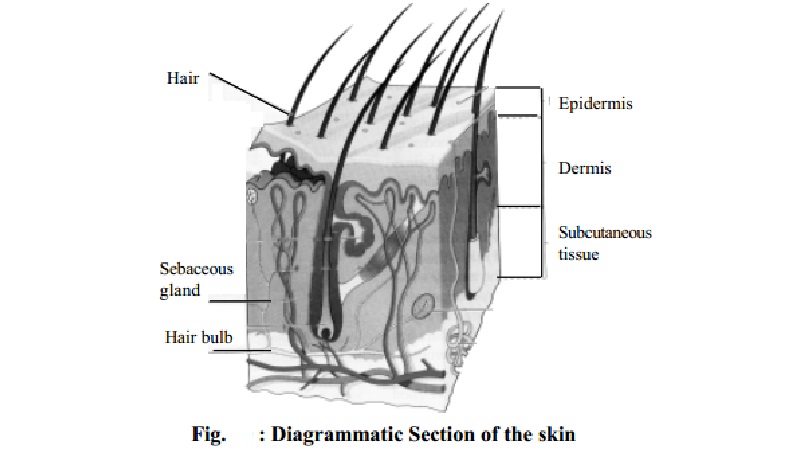Chapter: 11th 12th std standard Home Science Maintain Basic Knowledge for family life Higher secondary school College
Structure and Functions of the Skin

Structure and Functions of the Skin
The skin forms a protective outer covering around the entire body. It
consists of an outer thin layer called the epidermis
and an inner thick layer called the dermis.
Numerous structures such as glands, sense organs and appendages such as hair
nails are embedded in the skin.
Epidermis
This is
the outermost thin portion of the skin. No blood vessels are found in this
layer. It derives its nutrition from lymph. Nerves are found in this layer.
The Epidermis consists of four layers of cells.
They are:
The stratum corneum
The stratum lucidum
Stratum granulosum and
The stratum malpighi
The Stratum Corneum
The cells
in this layer are thin, scale-like, dead, and cornified. The corneous layer is
thickened in those parts of the body such as the palm and sole of the foot.
ii) The Stratum Lucidum
This is a
thin more or less transparent layer, in which the cells are indistinct.
iii) The Stratum Granulosum
It
consists of three to five layers of flattened cells containing dark granules of
irregular shape.
(iv) The Stratum Malpighi
This layer is the lowermost and broadest layer of the epidermis. It is
capable of active multiplication. This layer is made up of polyhedral cells.
These cells are called prickle cells. The innermost cells
of this layer contains pigment granules called melanin which give the
skin its colour.
Dermis
Situated
below the epidermis is the most thicker dermis formed mostly of connective
tissue which is richly supplied with blood vessels and nerves. The boundary
line between the dermis and epidermis is neither smooth nor straight; it is
rather zigzag because of the conical projection of the dermis into the
epidermis. These projections are called dermal papillae. This layer is
tough, flexible and highly elastic. It contains the following structures:
Fine elastic fibres.
Capillary blood vessels and lymphatics.
Sensory nerve endings of various types.
Hair roots or hair follicles.
Sweat glands.
Sebaceous glands and
Involuntary muscle fibres. These muscle fibres, called arrectores pilorum are attached to the hair follicle and when these muscles contract, the hairs become vertical
and 'goose - skin' is brought about.
There are two sets of glands in the skin. They are (1) the sweat glands
and (2) the sebaceous glands. Each sweat gland consists of a long tube which at
one end opens on to the surface through the sweat pore. At the other end, in
the deeper part of the dermis, the tube forms a coiled mass with a blind end.
In the coiled portion of the sweat gland, there are glandular cells, which
separate water and small quantities of metabolic waste products from the blood
that circulates through the capillary network associated with the gland. The
sweat passes through the sweat pore and evaporates from the surface by taking
heat from the skin. The sweat glands are present in large amounts on the palms,
soles, forehead and in the armpits.
The
sebaceous glands are irregularly shaped sac - like glands that open into the
hair follicles. The oily secretions (Sebum) of these glands make the hair
waterproof and protect the skin from drying effects of the atmosphere due to high
temperatures and low humidity.
Sensory Nerve Endings
Numerous
sensory nerves specialized to pick up stimuli that cause sensations of touch,
pressure, pain, heat and cold that are scattered in the skin. They are
connected to the brain by nerve fibres. Stimuli picked up by the sense organs
are transmitted to the brain where they are interpreted to give the correct
information.
Appendages
Hair and nails are appendages of the skin formed as a result of the
outgrowth or thickening of the epidermis.
Functions of the skin
The skin is not merely an outer covering for the body but it serves a
variety of functions.
Protection: The skin protects the inner parts of the body from mechanical injuries. A healthy skin also protects the body from
the invasion of disease-causing germs. The nails, hoofs, and horns are also
defensive appendages of the skin.
Excretion: Like kidneys, the skin through its sweat glands, eliminates salts, and metabolic waste products in the form of
sweat.
Sensory Function : The numerous sense organs and nerve endings hidden in the skin make it an important sensory structure that
picks up different stimuli and inform the brain of such changes in environment.
Production of Vitamin D : The skin contains a substance called 7-de-hydro cholesterol which is converted into vitamin D by ultra violet rays of the sun.
Regulation of Body
Temperature : By conduction, convection and radiation - a large amount of heat is lost from the body. The
subcutaneous fat and hairs act as non-conductors of heat. Evaporation of sweat
takes away a large amount of heat from the body.
Water Balance : Formation and evaporation of sweat is an important factor in the regulation of water balance of the body.
Acid Base Equilibrium
: Sweat being acid in reaction, a good amount of acid is excreted through it.
In acidosis, it becomes more acid and in this way helps to maintain a constant
reaction in the body.
Secretion : Sebum which is secreted by the Sebaceous glands helps to keep the skin greasy and prevents drying. Sweat is
secreted by sweat gland. Milk is secreted by mammary gland. The mammary glands
are the skin structures. They are the modified sebaceous glands.
Storage Function : The subcutaneous tissue can store - (a) fat (b) water (c) salts (d) glucose and such other substances.
Related Topics